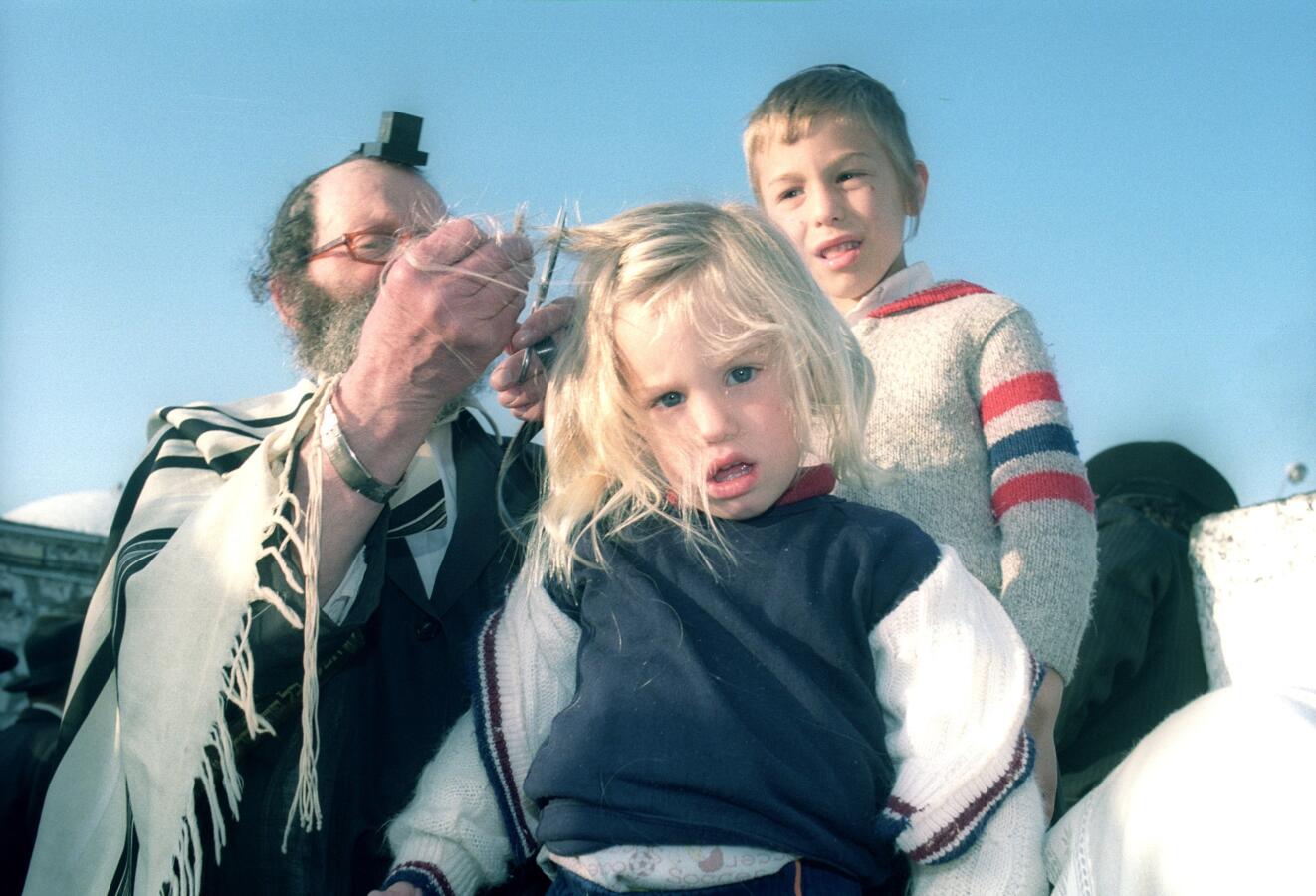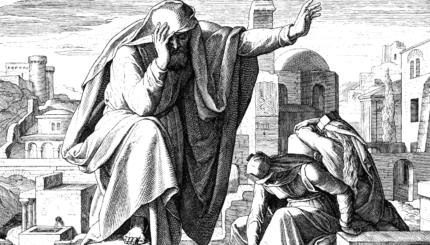The classical Jewish sources offer some definite guidelines about how to cut a child’s hair, but say virtually nothing about when this procedure should be carried out. For example, the Torah prohibited the shaving of the sideburns, and the Talmudic discussion concerned itself with the precise definition of what counts as a sideburn for purposes of this law. However, nowhere in the Bible or Talmud do we find any indication of a special ritual for the first cutting of the hair.
A Virtual Festival
In the abundant body of medieval literature that was devoted to the meticulous description of personal and local customs, whether in Germany, France, Spain or other centers of Jewish habitation, we hear not a single mention of any obligatory time or method for a child’s first haircut.
As was true with respect to many areas in Jewish religious customs, a fundamental turning point occurred in the 16th century among the residents of the mystic northern Israeli town of Safed. The disciples of the renowned Kabbalistic teacher Rabbi Isaac Luria (the “Ari”) reported that their revered teacher used to go to the tomb of Rabbi Shimon ben Yohai in Meron to cut the hair of his young son “in accordance with the well-known custom.” The day was celebrated as a virtual festival.
Evidently, Rabbi Luria’s custom was not associated with a particular date on the calendar. A later tradition cited in his name associated the first haircut with the child’s third birthday. Among the Safed mystics, the custom arose of cutting the haircut on Lag Ba’Omer, which was celebrated as the yahrzeit (Hebrew anniversary of the death) of Rabbi Shimon ben Yohai who was venerated as alleged author of the Zohar, the central document of Kabbalistic teaching. Lag Ba’Omer became the occasion of a festive pilgrimage to Rabbi Shimon’s tomb in Meron. It is impossible to trace the origins of this “well-known custom,” inasmuch as Safed itself had virtually no Jewish history prior to its rise to eminence in the days of Rabbi Luria and his school following the expulsion of the Jews from Spain and Portugal.
An important clue to the practice’s source is suggested by the fact that it was usually referred to as halaqah, from an Arabic word designating the cutting of hair. Indeed, examination of Middle Eastern folk practices reveals that offerings of hair were used for diverse religious purposes, including vicarious sacrifice, fulfillment of vows (in a manner reminiscent of the biblical nazir), or as a rite of passage. A ceremony called ‘Aqiqah is performed by many Muslims on the third, seventh or eighth day after a birth, and it is often associated with the baby naming. The ceremony normally included a ritual cutting of the infant’s first hair, alongside the offering of an animal sacrifice. Of especial relevance to our topic is the custom among Arab mothers of consecrating their children to God or to a saint in return for a safe childbirth. At some subsequent point in the lad’s life, his hair is ritually cut at a religious sanctuary or shrine as payment of the vow. Until the completion of the vow, it was forbidden to cut the child’s hair. This practice is attested among the Muslims of Safed.
Among Greek Catholics in Northern Syria, a collective shearing of 12-year-old boys was held on April 23, a date that is intriguingly close to that of Lag Ba’Omer.
Early descriptions of the Jewish hair-cutting ritual also stipulate that the hair should be weighed, and its equivalent in silver or gold donated to religious or charitable purposes. This element is also common to most of the non-Jewish versions of the practice.
Although the ritual came to be identified with the Lag Ba’Omer festivities at Meron, the timing was subject to several variations. Many Sephardic Jews preferred to hold it in the synagogue during the intermediate days of Passover. In Yemen, a festive cutting of the bridegroom’s curls was incorporated into wedding ceremonies. On that occasion, the couple’s 3-year-old relatives were also given their first haircuts.
In reality, the practice of offering one’s hair for a religious purpose is a very ancient one, and was very widespread among the ancient Greeks. It was customary for youths in those days to shave their heads, or a particular lock that was grown for that purpose, as part of a coming-of-age rite, offering it to Apollo, Heracles or a river god. These rituals were frequently associated with boisterous carousing, and were singled out by the rabbis of the Talmud as idolatrous acts that should not be emulated or assisted by self-respecting Jews (even if they happened to be barbers).
The Kabbalistic and Hasidic circles that rediscovered these dubious customs many centuries later possessed a marvelous flare for providing ingenious proof-texts to justify them. A favorite precedent was the biblical law of orlah that forbids the eating of fruit until after the tree has passed its third year. An old midrashic text had drawn a general symbolic comparison between the fruit and a human child, inspiring later rabbis to extend the analogy to the child’s first haircut, which marks a significant milestone in the development process.
Even cleverer was a tradition ascribed to Rabbi Isaac Luria himself, based on the Torah’s procedures for purifying one afflicted with a skin disease. At a certain stage in the process, the Torah (Leviticus 13:33) requires that the patient’s hair be shaved. The Hebrew word for “shave,” vehitgaleah, is standardly written with an oversized gimel, a letter that has the numerical value of three. This calligraphic peculiarity was seized upon as a biblical mandate for the practice of cutting the hair of three-year-old boys.
Whether under the Arabic name halaqah or its Yiddish equivalent upsherin, the religious ceremonies for the first haircut were generally confined to specific communities of Sephardic Kabbalists or East European Hasidim. In recent years they have enjoyed a more general popularity.
As with many folk customs, it is difficult to draw precise lines between the diverse elements of pagan superstition, inter-religious borrowing, mystical secrets, and normative Jewish observance. The distinctions between these realms can be as thin as a hair.
Reprinted with permission of the author from the Jewish Free Press (May 3, 2001).
Hasidic
Pronounced: khah-SID-ik, Origin: Hebrew, a stream within ultra-Orthodox Judaism that grew out of an 18th-century mystical revival movement.
Kabbalah
Pronounced: kah-bah-LAH, sometimes kuh-BAHL-uh, Origin: Hebrew, Jewish mysticism.
Sephardic
Pronounced: seh-FAR-dik, Origin: Hebrew, describing Jews descending from the Jews of Spain.
Talmud
Pronounced: TALL-mud, Origin: Hebrew, the set of teachings and commentaries on the Torah that form the basis for Jewish law. Comprised of the Mishnah and the Gemara, it contains the opinions of thousands of rabbis from different periods in Jewish history.
Torah
Pronunced: TORE-uh, Origin: Hebrew, the Five Books of Moses.



